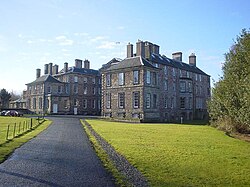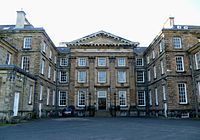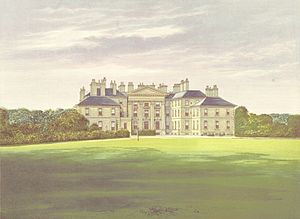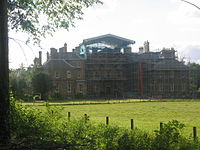Dalkeith Palace
| Dalkeith Palace | |
| Midlothian | |
|---|---|
 Dalkeith Palace | |
| Location | |
| Location: | 55°53’52"N, 3°3’59"W |
| Town: | Dalkeith |
| History | |
| Country house | |
| Information | |
| Owned by: | Duke of Buccleuch, leased to The University of Wisconsin |
Dalkeith Palace in Dalkeith, Midlothian, is a historic house and the former seat of the Duke of Buccleuch. The present house was built in 1702 on the site of an earlier castle.
Contents
The mediæval castle and the collegiate church
Dalkeith Castle was located to the north east of Dalkeith, and was originally in the hands of the Graham family in the 12th century and given to the Douglas family in the early 14th century. James Douglas of Dalkeith became the Earl of Morton in the mid 15th century. The castle was strategically located in an easily defensible position above a bend in the River North Esk. Nearer the centre of Dalkeith, James Douglas, 1st Lord Dalkeith, endowed the collegiate church in 1406, where Douglas earls lords and knights were buried.
Margaret Tudor, the bride of King James IV of Scots, stayed here as the guest of the John Earl of Morton before her formal entry to Edinburgh in 1503.[1] In 1543, David, Cardinal Beaton, the Archbishop of St Andrews, was imprisoned in Dalkeith Castle. The castle was captured during the war of the Rough Wooing by the English soldiers James Wilford and Thomas Wyndham on 3 June 1548.[2]
From June 1574, James Douglas, 4th Earl of Morton, the Regent, who had been captured at the siege of 1548, extended the castle and palace.[3] Its appearance was recorded in an engraving c.1690 by John Slezer. When James VI of Scotland reached his majority in October 1579, following celebrations in Edinburgh, Morton entertained the young King at Dalkeith Palace.[4]
The building is called a palace in part because Dalkeith Castle was the 'caput', the 'head' or place where the courts of the Regality of Dalkeith were held.[5] According to the heraldic writer Alexander Nisbet, the caput of a regality was technically termed a 'palatium', as a seat of royal authority.[6]
The Dukes of Buccleuch and the 1702 house
In 1642, Dalkeith Castle was sold by the Douglas family to Francis Scott, 2nd Earl of Buccleuch.
The 2nd Earl of Buccleuch's daughter married the Duke of Monmouth, eldest illegitimate son of King Charles II. They became the Duke and Duchess of Monmouth and Buccleuch. After the Duke of Monmouth had been executed for treason, Anne Scott, his widow returned to Dalkeith. She later asked the architect James Smith to use William of Orange's Palace of Het Loo in the Netherlands as a model for the new Dalkeith Palace.
Smith and his cousins, Gilbert and James, signed the contract for mason work at Dalkeith Castle in March 1702. Construction of Dalkeith Palace began later that year, Smith deciding to incorporate a portion of the tower house of the old castle into the western side of the new structure. The outline of the old tower walls is still visible in the western facade of the palace today.
In 1704, William Walker and Benjamin Robinson, the chamberlain of the Duchess, went to London with a small party to choose items of furniture for the palace. Construction was proceeding at a steady pace, and the main portion of the palace was roofed by the end of 1705. The London marble-cutter Richard Neale spent sixty-four weeks at the palace with nine assistants between 1709 and 1711, carving the main stairwell and screen of the Great Staircase. Several marble chimney pieces were installed, as well as an intricately carved marble bas-relief of Neptune and Galatea. This internally extensive use of marble was very much the taste of the Duchess. The majority of construction was complete by 1711.
Finishing touches on the Palace complex included adding a wrought iron screen with freestone piers (no longer existing) around the forecourt, a great deal of planting, and the laying out of a great avenue through the park. Dalkeith Park itself was a large area of manicured trees and gardens which in later years would include the Montagu Bridge over the North Esk River and the Dalkeith Conservatory and a grassed amphitheatre. When the final calculations were made, it was determined that the construction of Dalkeith Palace had cost the Duchess a total of £17,727.
The plumber John Scott of Edinburgh re-plated the roof in lead in 1743. Some minor additions were carried out in the following years. John Adam resurfaced the building in 1762 and James Playfair inserted a low window into the east facade in 1786.
Overall, the Palace is built of sandstone and has the main entrance on the south front, flanked on each side by two Corinthian order pilasters. These are surmounted by a bracketed pediment unusual for its depth. The layout of Dalkeith Palace was unusual for the time in that the state apartment was located on the ground floor, which prevented the Great Dining Room from being placed in its customary position at the start of the state apartment. As such, the Great Dining Room was placed on the first floor, still suitable for important occasions and also serving as an anteroom to another apartment on the first floor.
Subsequent history
The 5th Duke of Buccleuch considered extensive rebuilding in 1831 and William Burn produced unexecuted designs in Jacobean style. More minor alterations were carried out, together with improvements to the surrounding estate including a new house and offices for the Duke's Chamberlain, and the construction, for the 5th Duke, of St Mary's Church as a private chapel by William Burn and David Bryce. The church contains a rare water-powered organ.
Several well-known figures from British history have been guests at the Palace in the intervening centuries. Charles Edward Stuart ("Bonnie Prince Charlie") stayed two nights at Dalkeith in 1745, King George IV slept here during his visit to Edinburgh in 1822, in preference to Holyroodhouse Palace which was in a poor state, as did Queen Victoria in 1842.
Twentieth century
During Second World War, Polish troops of the 3rd Flanders Rifle Brigade, part of the 1st Polish Armoured Division, were quartered on the third floor of Dalkeith Palace from 1942 onwards. Graffiti drawn by these troops is still visible on the third floor wallpaper of the Palace.
In the 1970s and early 1980s, Dalkeith Palace was used as a research and development office by the computer firm International Computers Ltd. (ICL), who leased the Palace until 1983.
Dalkeith Palace has not been lived in by the Buccleuch family since 1914 and has been leased to the University of Wisconsin system for a study abroad programme since 1985. Approximately 60-80 students a semester live in the palace, where they also take classes.
Outside links
- John Slezer's view of Dalkeith Castle, c.1690 digital image
References
- ↑ Leland, John, De Rebus Britannicis Collectanea, .., ed., Hearne, Thomas, vol. 4, (1770), pp. 258-300.
- ↑ Calendar of State Papers Scotland, vol. 1 (1898), 115.
- ↑ Calendar of State Papers Scotland, vol.4 (1905), p.680, (building work noted June 1574)
- ↑ Calendar State Papers Scotland, vol.5 (1907), p.358 no.434.
- ↑ charter of novodamus of the Regality, 20/6/1589, Register of the Great Seal, RMS, vol.5, no.1674
- ↑ Nisbet, Alexander, System of Heraldry, vol.2 (repr. 1984), Part IV, p. 46


